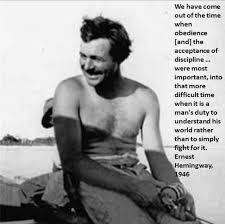The Hemingway Guide to Miami and Key West
• 11mo • 6 min read
Sparse of prose and generous with Martinis, Ernest Hemingway was nothing if not a literary and lifestyle legend. The iconic writer’s alpha male appeal has paved the way for no shortage of stories about his exploits — some canonical, like the three-month safari that resulted in a lion as a trophy, and others anecdotal, like his claim that he liberated the Ritz bar in Paris from the Nazis, or that he contributed to the invention of the Bloody Mary.

Hemingway adored the water — a fact evident in his novella, The Old Man and the Sea, which would prove to be his last major work of fiction. He dubbed his 38-foot fishing vessel the Pilar, evoking the nickname of his second wife, Pauline Pfeiffer, a name he would also bestow upon the leader of the partisan band in For Whom the Bell Tolls. He regularly fished off the coast of Key West when he lived there in the ’30s, and he also made three trips to the Bimini islands aboard the Pilar, catching numerous record-breaking fish, including a giant tuna.
His love of the sea has inspired Salty at Sea’s luxury yacht charters, but Double Threat has perhaps an even more Hemingway-an vibe about it. This company’s fishing exploits run at a “tournament-style pace” that seems right up his his alley, and setting out on such an adventure yourself may lead you to similar philosophical musings as those that dot his Old Man and the Sea: “You did not kill the fish only to keep alive and to sell for food, he thought. You killed for pride and because you are a fisherman. You loved him when he was alive and you loved him after. If you love him, it is not a sin to kill him. Or is it more?”
“I have drunk since I was fifteen and few things have given me more pleasure,” he wrote. “When you work hard all day with your head and know you must work again the next day, what else can change your ideas and make them run on a different plane than whisky?”

For this world traveler, drinking establishments were some of the best ways to get to know a new place.
“Don’t bother with churches, government buildings or city squares,” he wrote. “If you want to know about a culture, spend a night in its bars.”
Little Havana’s Café La Trova is an excellent place to start, evoking the Cuban culture that drew Hemingway to Havana in 1940; he would live there for two decades. The bar earned ninth place on the 2023 list of North America’s 50 Best Bars as much for the quality of its cocktails as for its ambiance. Here, drinks are thrown through the air, cantinero-style, with bravado and theatrical flair.
“I would serve him a Hemingway Special, aka Papa Doble, frozen,” he says. This play on a daiquiri features a double dose of light rum, maraschino, grapefruit juice, lime juice and, perhaps most essentially, no sugar for the sweet drink-averse Hemingway. It was originally crafted in Havana’s La Floridita, where he ostensibly once drank 17 in one sitting.”

“Drinking wine was not a snobbism nor a sign of sophistication nor a cult,” he wrote in A Moveable Feast. “It was as natural as eating and to me as necessary.”
Snobbery aside, we’re not sure he’d be able to shy away from the sophistication of the rarities on this list, which has featured such gems as a 1995 Château Margaux.
But should Hemingway belly up to the bar, Matador bartender Michael Berland has another perfect drink in mind.
“Hemingway loved handcrafted spirits made with fresh ingredients and a very dry, bone-chilling cold martini,” he says. (A love evoked, by the way, in A Farewell to Arms, where Frederic Henry cites the tipple as his drink of choice, claiming they make him feel “civilized.”)
“If I had the pleasure of mixing up a cocktail for the late Hemingway,” says Berland, “I would create a familiar and comforting cocktail for him such as the dry martini, making sure it is exactly how he likes it: ‘So cold you can’t hold it in your hand. It sticks to your fingers.’”
From Miami, it’s just a three-hour road trip to Key West, where Hemingway lived with his wife Pauline from 1931 to 1939. The house where he penned Green Hills of Africa and To Have and Have Not, among others, has been converted into a museum in his honor. Explore the grounds on your own or with a tour, and keep an eye out for one of the approximately 60 six-toed cats, some of which are descendants of Hemingway’s own Snow White.
While in Key West, be sure to stop by Sloppy Joe’s, Hemingway’s favorite local watering hole and notably where he met his third wife, Martha Gellhorn, whom he married after divorcing Pauline in 1940.





